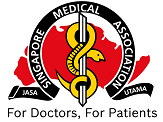22q11.2 deletion syndrome in Singapore (2000-2003): a case for active ascertainment
Share this Article
Singapore Med J 2008; 49(4):286-9
22q11.2 deletion syndrome in Singapore (2000-2003): a case for active ascertainment
×
![]()
Industrial accident-related ocular emergencies in a tertiary hospital in Singapore
Share this Article
Singapore Med J 2008; 49(4):280-285
Industrial accident-related ocular emergencies in a tertiary hospital in Singapore
×
![]()
Effect of basic military training on hearing in the Singapore Armed Forces
Share this Article
Singapore Med J 2008; 49(3):243-6
Effect of basic military training on hearing in the Singapore Armed Forces
×
![]()
Predictors of variceal bleed among patients with liver cirrhosis in the era of sclerotherapy
Share this Article
Singapore Med J 2008; 49(3):239-42
Predictors of variceal bleed among patients with liver cirrhosis in the era of sclerotherapy
×
![]()
Haemodynamic and ventilatory effects of preoperative epidural analgesia during laparoscopic hysterectomy using NICO
Share this Article
Singapore Med J 2008; 49(3):233-8
Haemodynamic and ventilatory effects of preoperative epidural analgesia during laparoscopic hysterectomy using NICO
×
![]()
Factors affecting the palpability of breast lesion by self-examination
Share this Article
Singapore Med J 2008; 49(3):228-32
Factors affecting the palpability of breast lesion by self-examination
×
![]()
A cumulative embryo scoring system for the prediction of pregnancy outcome following intracytoplasmic sperm injection
Share this Article
Singapore Med J 2008; 49(3):221-7
A cumulative embryo scoring system for the prediction of pregnancy outcome following intracytoplasmic sperm injection
×
![]()
Effects of cognitive-behavioural therapy on anxiety for children with high-functioning autistic spectrum disorders
Share this Article
Singapore Med J 2008; 49(3):215-20
Effects of cognitive-behavioural therapy on anxiety for children with high-functioning autistic spectrum disorders
×
![]()
Detection of sensorineural hearing loss using automated auditory brainstem-evoked response and transient-evoked otoacoustic emission in term neonates with severe hyperbilirubinaemia
Share this Article
Singapore Med J 2008; 49(3):209-4
Detection of sensorineural hearing loss using automated auditory brainstem-evoked response and transient-evoked otoacoustic emission in term neonates with severe hyperbilirubinaemia
×
![]()
Usefulness of a semi-quantitative procalcitonin test kit for early diagnosis of neonatal sepsis
Share this Article
Singapore Med J 2008; 49(3): 204-8
Usefulness of a semi-quantitative procalcitonin test kit for early diagnosis of neonatal sepsis
×
![]()


